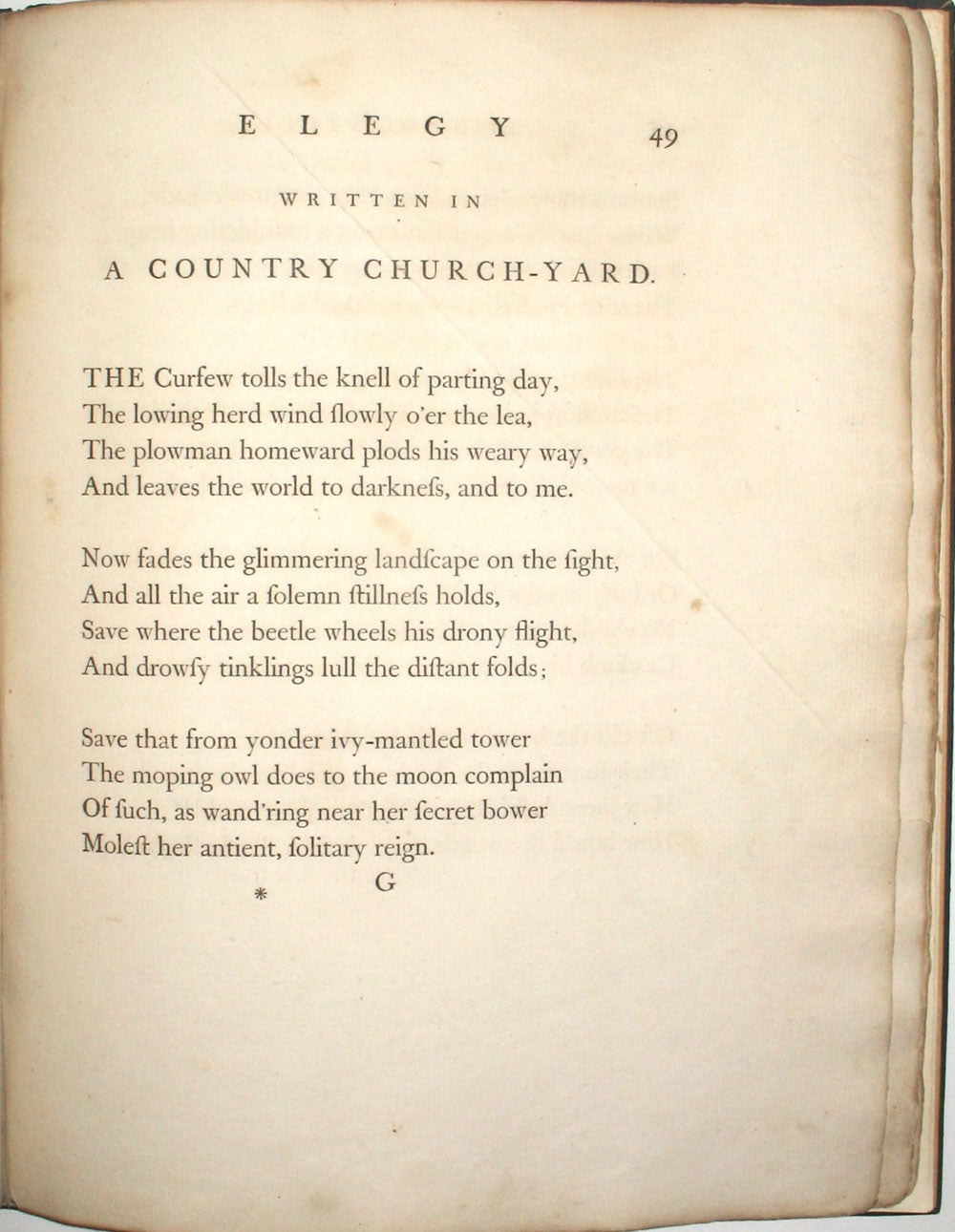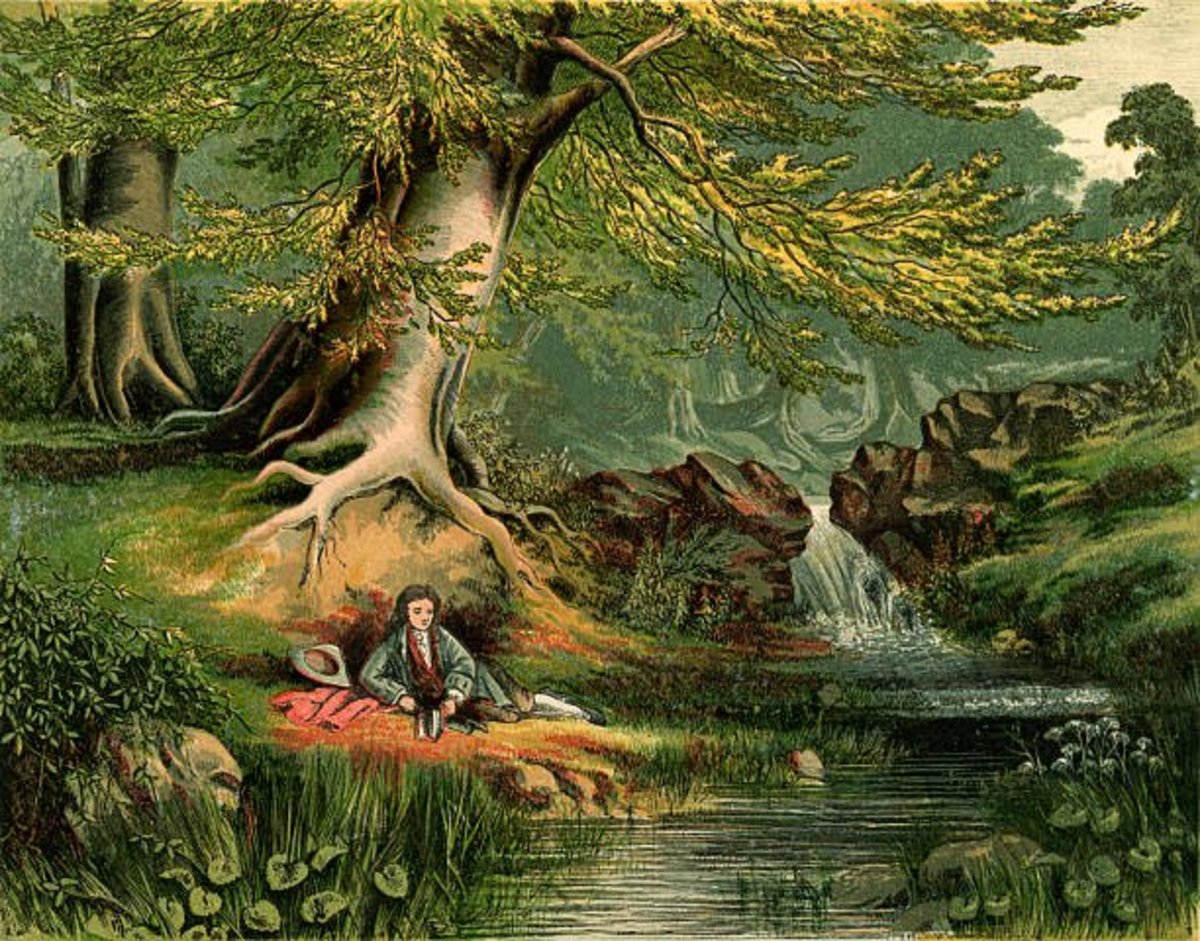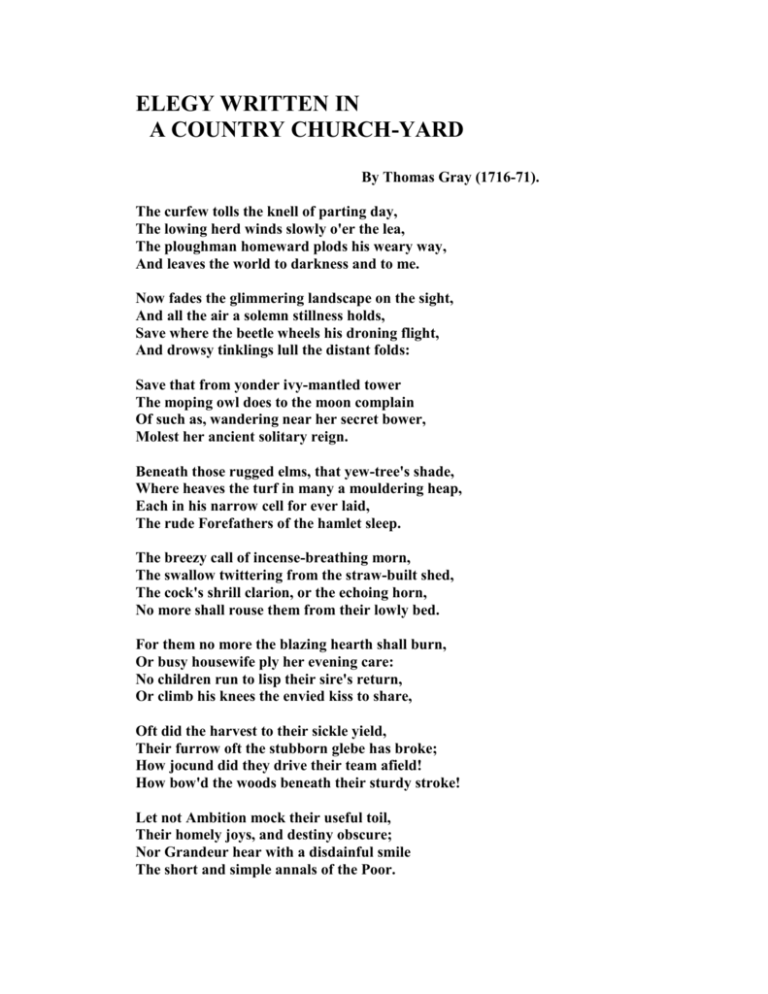
Gray's Elegy Written in a Country Churchyard, 1869, Chromolithographs
Elegy Written in a Country Churchyard Thomas Gray (1750) The lowing herd wind slowly o'er the lea, And leaves the world to darkness and to me. And all the air a solemn stillness holds, And drowsy tinklings lull the distant folds; The moping owl does to the moon complain. 10.

Gray's Elegy Elegy Written in a Country ChurchYard by Gray, Thomas
A meditation on unused human potential, the conditions of country life, and mortality, An Elegy Written in a Country Church Yard is one of the best-known elegies in the language. It exhibits the gentle melancholy that is characteristic of the English poets of the graveyard school of the 1740s and '50s. The poem contains some of the best-known.

Elegy written in a Country Churchyard Thomas Gray English Grammar A
In these lines from Elegy Written in a Country Churchyard by Thomas Gray, the poet introduces a picturesque image of a tower covered in ivy and describes the mournful cry of an owl. The tower, adorned with ivy, adds a sense of antiquity and mystique to the scene. The use of "moping owl" creates an image of a sorrowful or brooding owl, contributing to the overall melancholic tone of the poem.

Thomas Gray / Elegy Written in Country Churchyard by T Grey illustrated
Gray lost his father in 1741 and a close friend named Richard West in 1742; that year, Gray wrote a sonnet for West. The rhyme scheme of the sonnet is similar to the rhyme scheme of "Elegy Written in a Country Churchyard," although the sonnet is widely considered an inferior poem (Gray, Thomas. "Sonnet [on the Death of Mr. Richard West]."

PPT "Elegy Written in a Country Churchyard" By Thomas Gray
Elegy Written in a Country Churchyard. Thomas Gray. The curfew tolls the knell of parting day, The lowing herd winds slowly o'er the lea, The ploughman homeward plods his weary way, And leaves the world to darkness and to me. Now fades the glimmering landscape on the sight, And all the air a solemn stillness holds, Save where the beetle wheels.

Gray's Elegy Written In A Country Churchyard at 1stdibs
Elegy Written in a Country Churchyard. By Thomas Gray. The curfew tolls the knell of parting day, The lowing herd wind slowly o'er the lea, The plowman homeward plods his weary way, And leaves the world to darkness and to me. Now fades the glimm'ring landscape on the sight,

Elegy Written in a Country Churchyard by Thomas Grey Marks 5 4th SEM
Resources. "Elegy Written in a Country Churchyard" is the British writer Thomas Gray's most famous poem, first published in 1751. The poem's speaker calmly mulls over death while standing in a rural graveyard in the evening. Taking stock of the graves, he reflects that death comes for everyone in the end, and notes that the elaborate tombs of.

Thomas Gray, Elegy in a Country churchyard Ploughmans, Elegy, Weary
Thomas Gray began work on the "Elegy" in 1742. The setting may be in Stoke Poges, where Gray's mother was buried, and where his own remains would eventually lie. But the poem was probably composed.

Poems by Mr. Gray. Including the 'Elegy Written in a Country Churchyard
The Thomas Gray Archive is a collaborative digital archive and research project devoted to the life and work of eighteenth-century poet, letter-writer, and scholar Thomas Gray (1716-1771), author of the acclaimed 'Elegy Written in a Country Churchyard' (1751).

Gray's Elegy Written In A Country Churchyard at 1stdibs
First page of Dodsley 's illustrated edition of Gray's Elegy with illustration by Richard Bentley. Elegy Written in a Country Churchyard is a poem by Thomas Gray, completed in 1750 and first published in 1751. [1] The poem's origins are unknown, but it was partly inspired by Gray's thoughts following the death of the poet Richard West in 1742.

Washington, D.C. Elegy Written in a Country Churchyard Letter Grey
Summary. This study guide for Thomas Gray's Elegy Written in a Country Churchyard offers summary and analysis on themes, symbols, and other literary devices found in the text. Explore Course Hero's library of literature materials, including documents and Q&A pairs.

'I remember, I remember' what's the point of learning poetry?
Thomas Gray may have begun writing Elegy Written in a Country Churchyard as early as 1746. He discarded four stanzas of an early version, which were probably read by his friend Horace Walpole, and planned to title the work simply "Stanzas" until his friend William Mason suggested "Elegy" instead. A meditation in a burial ground….

Rachel Rosenthal on HubPages
Introduction. Thomas Gray's "Elegy Written in a Country Churchyard," first published in 1751, stands as one of the most beloved and enduring poems in English literature. Combining elegiac and pastoral elements, the poem eloquently contemplates the transient nature of life, the equality of death, and the legacy left by ordinary individuals.

The Elegiac Notes in Gray’s “Elegy Written in a Country Churchyard
By Dr Oliver Tearle (Loughborough University) There was a time when every schoolchild could quote lines from Thomas Gray's poem 'Elegy Written in a Country Churchyard', since it was a popular poem to be taught, learnt by rote, and analysed in schools in Britain. Gray's poem gave Thomas Hardy the phrase 'far from the madding…

Gray`s Elegy Written in a Country Churchyard
Thomas Gray began to write "Elegy Written in a Country Churchyard" in 1742, shortly after the death of Gray's friend Richard West, and published it in 1751. An elegy is loosely defined as a.

Elegy written in a Country Churchyard', by Thomas Gray, 1751
Literary Style. PDF Cite Share. "Elegy Written in a Country Churchyard" is written in heroic quatrains. A quatrain is a four-line stanza. Heroic quatrains rhyme in an abab pattern and are written.